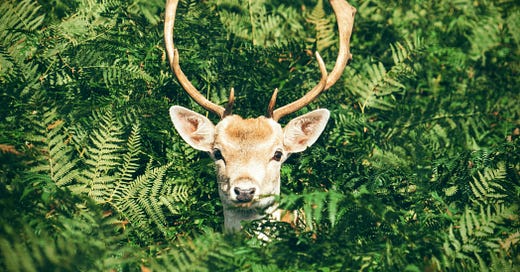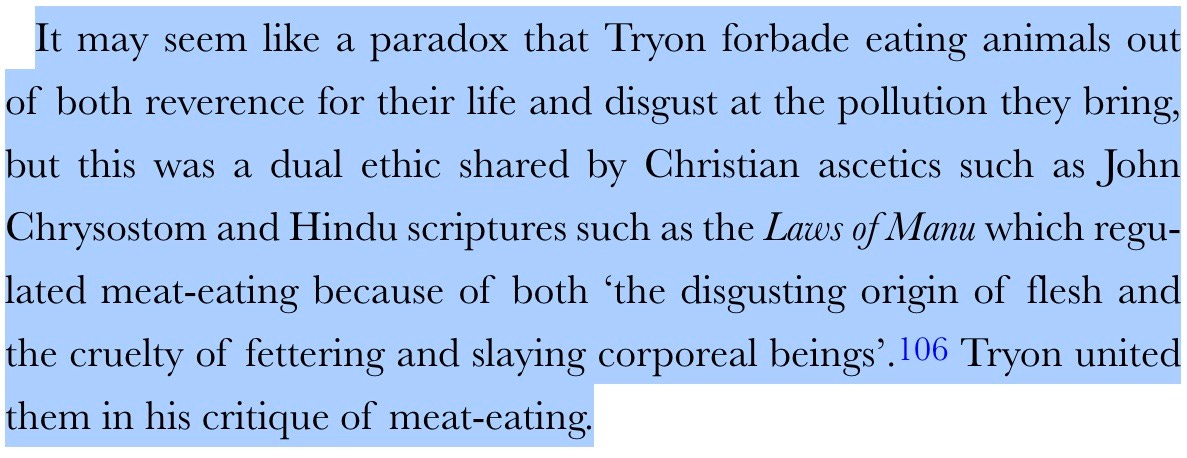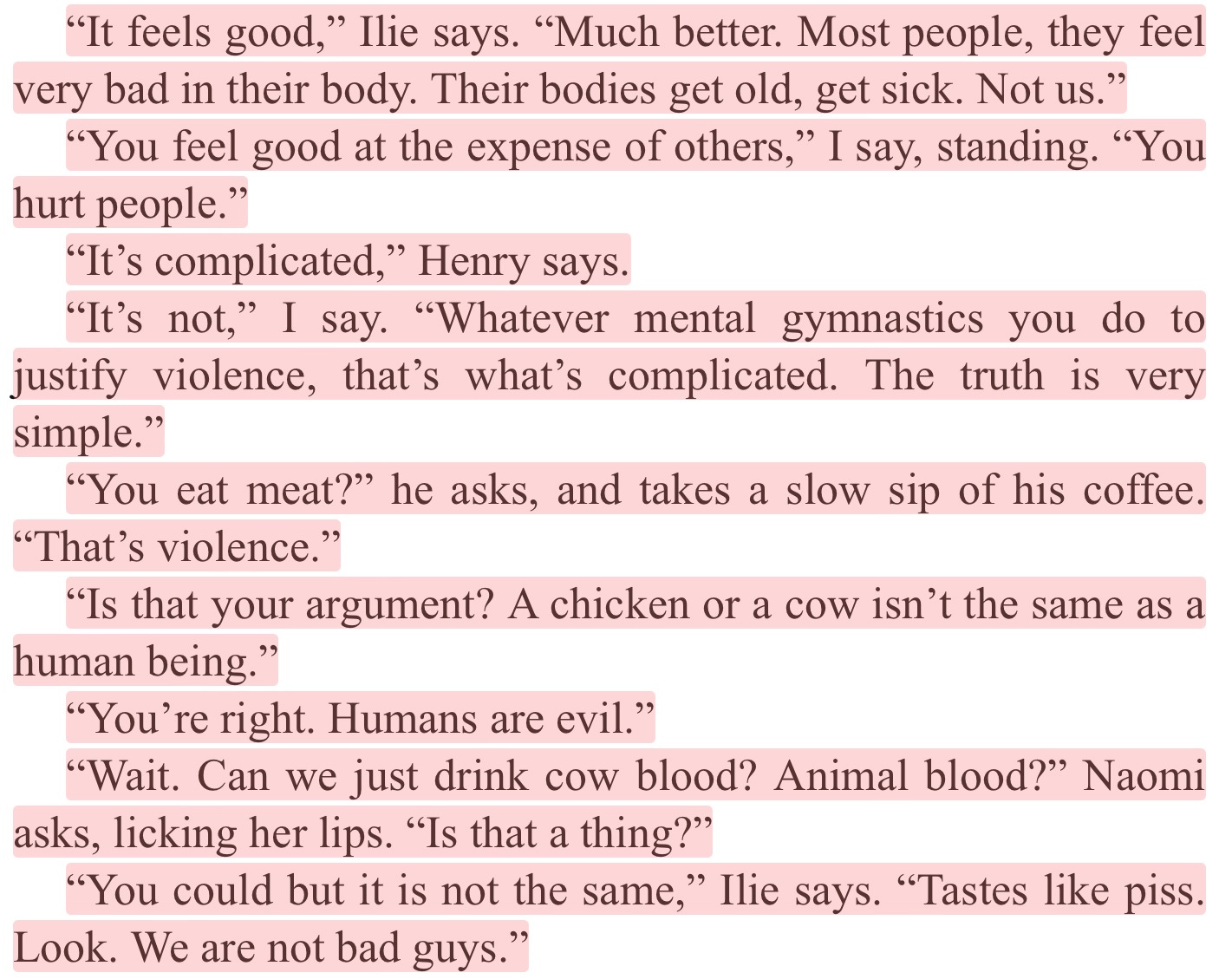“What’s it like to drink blood? Is it like drinking life itself?”
—Interview With the Vampire,
“Like the Light by Which God Made the World Before He Had Made Light”
I had just turned twelve, and my life was about to change forever.
After much hemming and hawing, my mom wrangled me into going to the movies with a coworker of hers and her daughter, who happened to be in my class at school. We settled into our seats in the packed theater, and soon the misty forest floor of Twilight’s first scene opened up on the screen. I knew nothing about the books, but the story engaged me from the very beginning. After Edward and Bella declared their love for one another and the new couple perched up in a towering pine tree, overlooking the vast forest around them, I thought to myself that I was just as in love with this story as these two were with each other.
I couldn’t stop thinking about the movie after leaving the theater. I couldn’t sleep that night. I needed more Twilight in my life—now! I borrowed the novels from a friend and devoured them whole. I surfed online to find fanart and news about the next movie. But that wasn’t enough; I couldn’t wait another whole year until New Moon came out.
So, massively crushing on Edward, I made the jump over to another fandom: Harry Potter. Thank God for ABC Family; their constant replays of the first Wizarding World movies allowed me to record Harry Potter and the Goblet of Fire, and I watched it over and over, without a clue as to what was going on. (The British accents and Wizardly slang didn’t help.) After tiring of Robert Pattinson’s meager role (and depressing death) in that movie, I finally cracked open the books.
By the time I finished all 11 tomes of these two series, I’d become the kind of person who could claim to enjoy reading, rather than doing it to fulfill a set number of hours over the summer.1 I was a new person, reborn.
Ethical Consumption Under Vampirism
There was one thing that always nagged at me with Twilight’s interpretation of vampires: the jestful “vegetarian” label. Bella’s favorite vampires, the Cullens, chose to only drink the blood of animals, believing it against their moral code to take human lives.
I hated them for that.
It’s not that I wanted them to hurt humans. It’s that everyone—from characters to fans—seemed to automatically accept that killing animals was the more ethical option. And while I remain a consummate rule-follower, and get shaky and sweaty when I stand out too much from the crowd, that nagging wrongness concerning “vegetarian vampires” has never abated.
Why didn’t the Cullens ever consider the deers, mountain lions, and bears they hunted? Why couldn’t Edward live with himself when he tried only killing violent criminals? Are animals really so worthless that a murderer or rapist’s life is more valuable than theirs?
Vampires exist as predators; they have no choice but to kill to survive.2 I don’t deny them that. But it’s the beings who can’t fight back, the ones who are physically incapable of harming or killing them that the vegetarian vampires target—the most innocent.3 At least human prey has a chance, however small, to fight and escape.
But even in stories where a bite doesn’t automatically turn their victim into a vampire—when the vampires can drink from humans without causing permanent harm—they still choose to drink from animals. Since I’ve yet to see a vampire take down an elephant or whale, the animals they hunt are smaller than them, and so they nearly always die. (Less blood + hungry vampire = dead animal.) When the brothers Salvatore try to keep a low profile in The Vampire Diaries, amoral Damon joins bleeding heart Stefan in chowing on critters (and blood bags) until their enemies stop sniffing around.
Case Study: Interview With the Vampire (2022-present)
Interview With the Vampire is, by far, the best show on today. It rekindled my burning love of suave, brooding vampires—something I’ve sorely missed in the horror genre. (Keep your gross monsters of 30 Days of Night. I don’t want them.) When protagonist Louis decides to stop eating humans in the first season, he can snatch up a rat and drain them dry in only a second or two, much to the disgust of his partner, Lestat. Their vampire daughter, Claudia, tries to support Louis but, well, let’s just look at this exchange:
Lestat: “Is it still four legs for Louis and two legs for Claudia?”
Louis: “I eat what I eat. She eats what she eats. We respect our differences.”
Lestat: “Well, it’s always made me feel loathsome, like I’m looked down upon for my body’s needs.”
Louis: “Well, you don’t actually need it.”
Lestat: “Mm. See, there it is. It’s an air of superiority when you say that.”
Claudia, begrudgingly, agrees with Lestat, and Louis agrees to go back to drinking human blood so they don’t feel bad.
Internalized Anthropocentrism
What’s so special about human blood that vampires have to work so hard to resist it? Biologically, what’s so different about human blood that it turns vampires’ eyes an entirely different color4 in Twilight than all other species in the animal kingdom? What’s so delectable about human blood that no other animals inspire the same kind of bloodlust? I’ve never found satisfactory answers to these questions.
I can understand why former humans may have difficulty killing humans, but even in stories where vampires are an entirely separate species of creature, the craving for human blood alone persists. (The moroi of Vampire Academy come to mind.) Sure, these stories are made by humans, for humans, but historically, vampires didn’t always make such distinctions. In old folktales, some vampires—or humans afflicted with vampirism—imbibed in animals. Cattle found dead in the morning could have been vampiric victims. It seems in modern society, vampires could easily hide under the radar, plucking off chickens or fishes from factory farms with humans being none the wiser.
But vampires will go to great lengths to avoid tainting their mouths with the blood of animals. The classy moroi of Vampire Academy compensate willing blood donors, with only rogue vamps hunting humans. Eating is as mundane for them as it is for us, and there’s no need to take more blood than a donor can give up. But if they bleed a human dry, their very soul becomes corrupted. They become strigoi, sociopathic monsters intent on killing not only humans but moroi, as well.
Their compulsion to feed on humans, the moral quandary of doing so, and the ethical, yet disgusting, act of drinking animal blood offer interesting parallels to human vegetarianism. Jamie Kreiner writes in Legions of Pigs in the Early Medieval West,
“What today we call vegetarianism and veganism were widely admired in mainstream Christianity as a core part of ascetic practice. If there was a celebrity diet in Late Antiquity and the early Middle Ages, it was this one, the regimen modeled by the late antique desert elders of Egypt and Palestine…. By withholding immediate gratification from the body’s most fundamental appetite of all—not sex, but eating—the mind and soul could be trained in the course of disciplining the body.”
Vegetarians were admired not necessarily because animals were seen as morally significant—though before Christianity wiped out pagan cultures, there was far more reverence for the interconnectedness of all life on earth—but quite the opposite. Eating animals was decadent, and the most pious could abstain from such temptation, becoming closer to God. When we look back at notable vegetarians from the sixteenth century onwards, many both valued animal life but also were disgusted by fueling their bodies—made in the image of God, remember—with the flesh of dirty, lowly beasts. Tristram Stuart says it best in The Bloodless Revolution:
Others “thought that animals that ate only vegetables essentially were vegetables,” Kathryn Shevelow notes in For the Love of Animals. By this rationale, “[milk], as a processed form of the grass eaten by cows, was believed to be a vegetable,” or at least outspoken vegetarian Dr. George Cheyne thought so.
Vampires use these same kind of rationalizations to both eat animals and abstain from doing so. “Bad” vampires like Lestat distance themselves from any moral code by calling humans “meat,” a signal of his own superiority to the species, and, intentionally or not, condemning “meat” animals.
Case Study: So Thirsty by Rachel Harrison
Rachel Harrison’s newest novel has something to say on this topic. The protagonist is offended on behalf of humanity that her new vampire coven has no respect for human life, and even more offended when one of the vampires calls out her own “violence.”
The gang of vamps later comes across another vampire whose tastes have expanded beyond blood:
“‘Have you ever tried?’ she asks, her eyes sparking red. ‘The taste of flesh? The crunch of bones between your teeth?’”
The normies express their disgust with her:
“‘You’re alone because of the company you keep, Alice,’ Henry says. ‘The company you choose. What you do to them.’”
It seems the parameters for acceptable vampiric behavior are quite narrow. Only (human) blood-drinking—and the occasional orgy—allowed.
Perfect Killing Machines
If everything about the Twilight vampires was designed to lure human prey—their voices, their faces, even their smells (that sounds less weird if you’ve read the books)—then I was in, hook, line, and sinker. I desperately wanted a handsome vampire to infect me with his venom. And, oh, how jealous I was of Rosalie, the most beautiful in the Cullen clan. Feeling invisible to all the boys in my class, I thought her horrifying backstory would be an alright price to pay. Because at least she was pretty enough to attract the attention of the men who attacked her. Really, I just wanted to look in the mirror and see that cool, chiseled marble skin, framed by long, luscious locks rather than my all-too-human frizzy gnarls of dull brown. But instead of those brilliant topaz eyes Bella adores, I wanted my irises to be livid crimson.
Though they appear human—dazzling diamond skin notwithstanding—a beast lurks beneath their skin. The romantic appeal of vampires goes back at least to Bram Stoker’s Dracula, with the titular bloodsucker’s hypnotic ability to lure in even wary humans. (We see this same thing in The Vampire Diaries, though they have a literal magical ability, called “compulsion,” to control human minds.)
Dracula’s command over “all the meaner things,” like bats, rats, wolves, and owls, allows him to transform into an animal. (At least wolves and bats, that we know of.) And the romantic becomes bestial. The lines between our strong primal emotions puncture—love, lust, disgust, hunger, desire, excitement, terror, pain, pleasure. There’s something titillating in the taboo, a desire to be overpowered, to be craved on a deep, primal level. To experience that irresistible pull between yourself and another. Perhaps that’s because we’re animals, too. We long to connect back with nature, to let go of romantic anxiety and doubt—to love wholly. Unconditionally and irrevocably.
Case Study: Nosferatu (1922)
Before Bela Lugosi graced the silver screen as a debonair Dracula in 1931, Max Schrek terrified audiences with his depiction of Count Orlock in Nosferatu, an unauthorized adaptation of Bram Stoker’s novel. With spindly fingers like spiders’ legs, elfin ears, and two rows of pointed fangs, he’s instantly identifiable as a monster. Unlike the entrancing Dracula, Count Orlock’s exaggerated, animalistic features force him to lurk in the shadows and pounce on unsuspecting prey like any nocturnal predator. The darkness aids his mission, swathing him in shadows, a natural camouflage.
My Vampiric Transformation
Vampires made me the person I am today. It’s hard to imagine what my life would look like had I not gone to see Twilight that day. Would I have ever watched the movies? Read the books? Maybe I’d be a superhero fanatic instead, or a Trekkie.
Though my wish to become a bloodsucker never came true (yet…?), all those vampires I’ve loved over the years inalterably changed me. My passion for their stories will live forever, so, in that way at least, I have achieved immortality.
On my mind: Bunnicula by Deborah & James Howe
This is a delightful children’s novel about a vampire bunny—a true vegetarian vampire. Rather than drinking blood, precious little Bunnicula sucks the juice from vegetables. I find it curious that Chester the cat is so convinced that Bunnicula is evil, despite his herbivorous diet. You’d think that animals—say, a cat and dog—who eagerly devour the flesh of other animals may be more suspicious than a juice-drinking rabbit.

Of course, Chester and Harold (the dog) could just ask Bunnicula about his supposed plans for world domination, but it seems he doesn’t speak the same language as the two protagonists. Chester and Harold can’t communicate with humans, but they can read and write in English (as well as speak to other species in later books in the series), so perhaps it’s best not to overthink the logic.
Lisi Harrison’s middle-grade series The Clique notwithstanding. I still have all 14 of my original books that are desperately calling to me for a reread.
As an aside, I wonder how vampire venom affects animals in the Twilight universe? While vampires can sometimes stop their feeding “frenzy” to make new vampires, we never see any animals turned into blood-drinkers. Frankly, I’d be more interested in that story now.
The vampires of Twilight can only be killed by being ripped apart and burned, and their flesh is as solid as marble.
For those unfamiliar with this brand of vampire, their irises turn either brown or red depending on what kind of blood they drink (brown = animal, red = human)








I've never been one for Vampire stories, but I do very much appreciate now being made aware of Bunnicula. What a novel idea, to drink the juices of vegetables rather than go for the blood of other living beings. Just great!